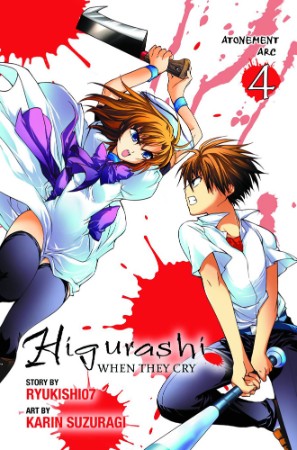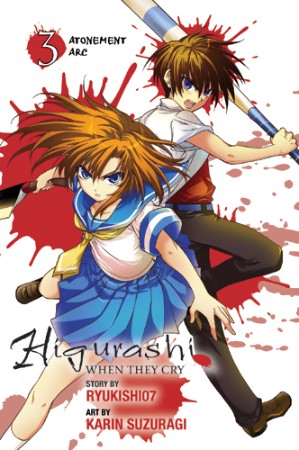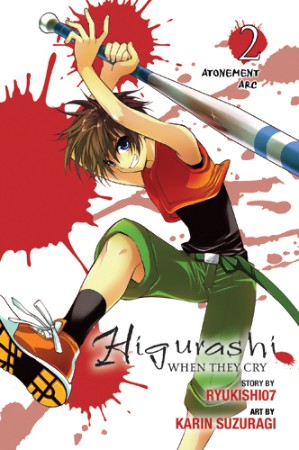Story by Ryukishi07; Art by Karin Suzuragi. Released in Japan as “Higurashi no Naku Koro ni: Tsumihoroboshi-hen” by Square Enix, serialized in the magazine Gangan Powered. Released in North America by Yen Press.
This is a revelatory volume of Higurashi, both in the way that it wraps up the plotline with Rena and Keiichi, and in the way that it affects Rika, who is turning out to be the real star of the series. Of course, we have a ways to get there. First off, we deal with Rena’s continuing slide into madness, which culminates in her holding the entire school hostage and dousing it with gasoline. (Thank heavens this isn’t Naruto-level popular, I have to say, or the censors might wake.)
There’s not as much creeping paranoid horror as there was in the previous three volumes, mostly because Rena’s all the way there. That said, there are some impressive visuals from artist Karin Suzuragi. The way the panels and pages are set up and flow from one to another is very well done, and there’s lots of ‘turn the page and be shocked’ moments, particularly when Keiichi realizes he’s been tricked with the fake bomb. And, of course, Rena’s ‘Higurashi faces’ are impressive as well, though the best and most terrifying of those is at the end of the next arc.
Rika had mentioned last time that it was too late to save this world, but Keiichi is trying to make her realize that it’s not just about ‘how do I avoid getting disemboweled’ but about trying to prevent the little tragedies. She was already stunned that he remembered a previous world where he was the instigator. Now, in teaming up with Keiichi and Satoko to stop Rena, she decides after so long to try to stop fate even if it is impossible. (I love her cynical face as she faces off against Rena – we’re seeing more and more of the Rika that remembers every single go-round, and must be far older than 10 years old.) Incidentally, when Rika tells Keiichi that last time she didn’t try hard enough and Rena succeeded? We’ve seen that world too, in the Beyond Midnight arc.
Satoko is also impressive here, and it’s nice to see an arc where she’s less physically and mentally abused. Mion also gets a fantastic moment at the very start of the volume, reminding you that she is indeed the heir to a huge yakuza family and has no intention of doing anything else when she grows up. Mostly, however, she is the abused one in this volume, getting the blunt end of Rena’s billhook to the head in a mistaken belief that her family is behind everything that’s happened for the last few hundred years. In the end, though, this is about Rena and Keiichi.
There really aren’t as many “ship wars” as you’d expect from a harem series in Higurashi fandom. Partly as it ends up being about friendship, partly as little is resolved one way or the other. Keiichi/Rena fans, however, can be happy that the most shippy of their arcs was adapted for manga – Keiichi/Mion fans have to say “But hey, we got the PS2 arc!”. It will be hard to top this, though. The fight on the roof is fantastic, the best Keiichi has ever been, showing him finally breaking through to Rena not by pleading and making sense, but by the game they started with. This arc has been very cyclical, with Keiichi’s need to atone going back to the first arc. Now we end as we began, with a battle between friends – only instead of water, they have lethal weapons in their hands. But lethal weapons are only lethal if they’re used.
Rena’s been very clever through this volume – she’s one of the smartest in the cast, and implied, like Keiichi, to be playing stupid much of the time. But perhaps her finest hour is being able to break through the madness that has gripped every antagonist in this series to date, before killing him. Keiichi realizes how amazing this is, praising her for it in text. By distracting her with the roof battle “game”, he was able to remind her of the fun they all had – and also of her love for Keiichi, and his love for her. They both seem to know it’s not to be – there’s still a certain fatalism here – but Rena cries, and repents her earlier actions. She’s no longer crazy.
And so this arc ends, with the schoolchildren safe, Keiichi and Mion alive, Rena sane, and a final speech by Rika and Keiichi about finding the strength to fight fate, and that they’ll kick back against it as many times as they have to. Which is good, as after this happy ending (the chapter is called “Happy Rena”, anotehr cyclical bookend), we turn the page… and the whole village is dead again. Yes, we’ve managed to resolve Rena’s issues, but Rena was never the one who was disemboweling Rika on an altar, and the main villain is still unknown (though I can hazard a guess). The manga actually makes our irritation at another bad end explicit, with “The End” appearing 25 pages early, and then someone (Bernkastel?) chiding us for ruining the happy ending by turning the page. And so we’re left with Akasaka, 25 years later, wondering what could have stopped this horrific tragedy.
Overall, this arc was one of the best of the series, especially for fans of Rena, its iconic character. Higurashi now takes a summer break, but Yen Press will return in September with what I’m sure will be the final arc in the series, in which everyone lives happily ever after.
After all, how could the “Massacre Arc” possibly be bad?





